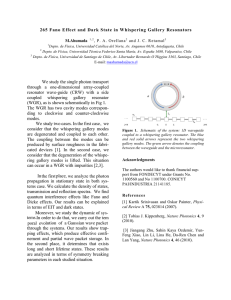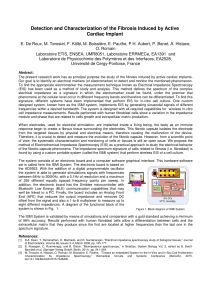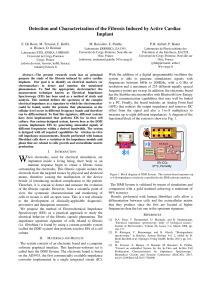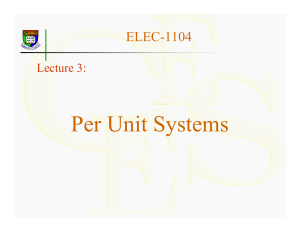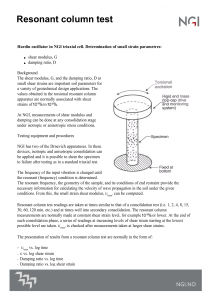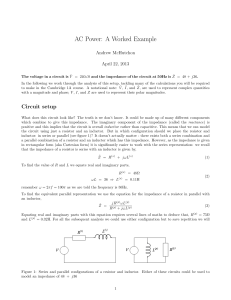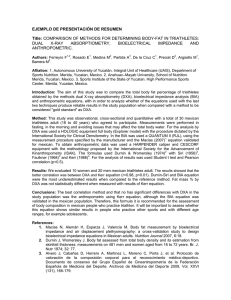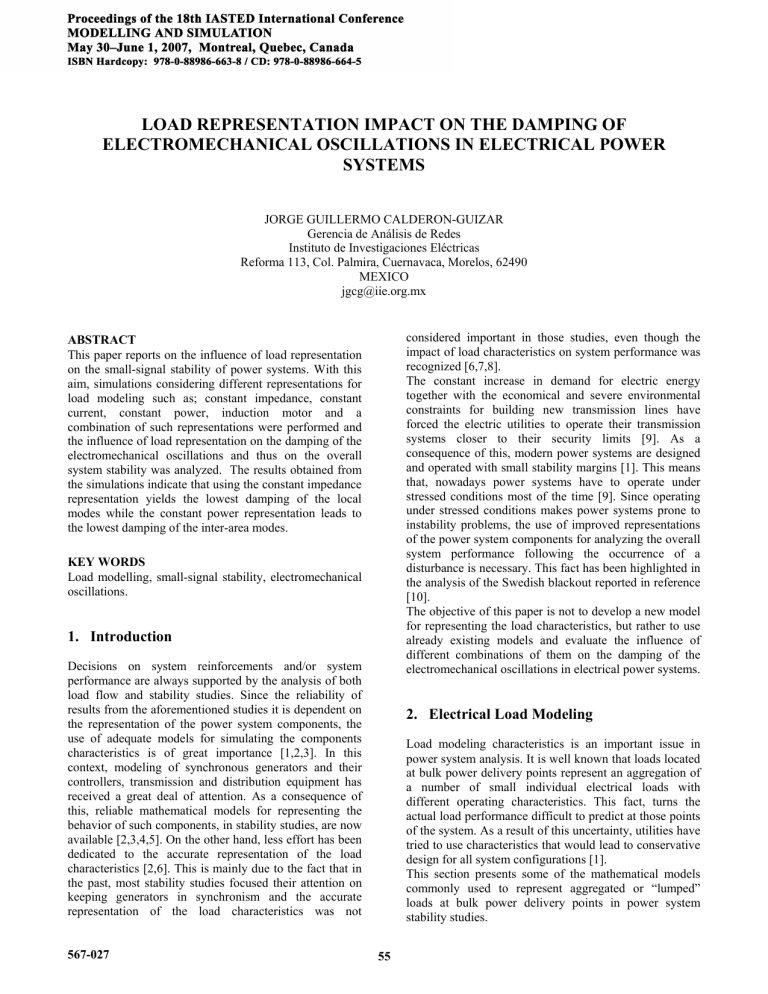
LOAD REPRESENTATION IMPACT ON THE DAMPING OF ELECTROMECHANICAL OSCILLATIONS IN ELECTRICAL POWER SYSTEMS JORGE GUILLERMO CALDERON-GUIZAR Gerencia de Análisis de Redes Instituto de Investigaciones Eléctricas Reforma 113, Col. Palmira, Cuernavaca, Morelos, 62490 MEXICO [email protected] considered important in those studies, even though the impact of load characteristics on system performance was recognized [6,7,8]. The constant increase in demand for electric energy together with the economical and severe environmental constraints for building new transmission lines have forced the electric utilities to operate their transmission systems closer to their security limits [9]. As a consequence of this, modern power systems are designed and operated with small stability margins [1]. This means that, nowadays power systems have to operate under stressed conditions most of the time [9]. Since operating under stressed conditions makes power systems prone to instability problems, the use of improved representations of the power system components for analyzing the overall system performance following the occurrence of a disturbance is necessary. This fact has been highlighted in the analysis of the Swedish blackout reported in reference [10]. The objective of this paper is not to develop a new model for representing the load characteristics, but rather to use already existing models and evaluate the influence of different combinations of them on the damping of the electromechanical oscillations in electrical power systems. ABSTRACT This paper reports on the influence of load representation on the small-signal stability of power systems. With this aim, simulations considering different representations for load modeling such as; constant impedance, constant current, constant power, induction motor and a combination of such representations were performed and the influence of load representation on the damping of the electromechanical oscillations and thus on the overall system stability was analyzed. The results obtained from the simulations indicate that using the constant impedance representation yields the lowest damping of the local modes while the constant power representation leads to the lowest damping of the inter-area modes. KEY WORDS Load modelling, small-signal stability, electromechanical oscillations. 1. Introduction Decisions on system reinforcements and/or system performance are always supported by the analysis of both load flow and stability studies. Since the reliability of results from the aforementioned studies it is dependent on the representation of the power system components, the use of adequate models for simulating the components characteristics is of great importance [1,2,3]. In this context, modeling of synchronous generators and their controllers, transmission and distribution equipment has received a great deal of attention. As a consequence of this, reliable mathematical models for representing the behavior of such components, in stability studies, are now available [2,3,4,5]. On the other hand, less effort has been dedicated to the accurate representation of the load characteristics [2,6]. This is mainly due to the fact that in the past, most stability studies focused their attention on keeping generators in synchronism and the accurate representation of the load characteristics was not 567-027 2. Electrical Load Modeling Load modeling characteristics is an important issue in power system analysis. It is well known that loads located at bulk power delivery points represent an aggregation of a number of small individual electrical loads with different operating characteristics. This fact, turns the actual load performance difficult to predict at those points of the system. As a result of this uncertainty, utilities have tried to use characteristics that would lead to conservative design for all system configurations [1]. This section presents some of the mathematical models commonly used to represent aggregated or “lumped” loads at bulk power delivery points in power system stability studies. 55 id = 2.1 Static Load Models [R (V − E ) − X (V − E )] s ' d d iq = ' q q Rs2 + X 2 [− X (V − E ) + R (V − E )] ' This type of models, assume that load characteristics may be represented as algebraic functions of the instantaneous values of voltage magnitude at load buses. Mathematically, these assumptions may be represented as shown below; ' ' d d s q ' q Rs2 + X 2 Te = Ed' id + Eq' iq ; (3) Tm = Tnomωk Where; 2.1.1 Polynomial or ZIP model, ⎡ ⎛V P = P0 ⎢ Ap ⎜⎜ ⎢ ⎝ V0 ⎣ 2 ⎤ ⎞ ⎟ + Cp⎥ ⎟ ⎥ ⎠ ⎦ 2 ⎤ ⎛V ⎞ + Bq ⎜⎜ ⎟⎟ + C q ⎥ ⎥ ⎝ V0 ⎠ ⎦ ⎞ ⎛V ⎟ + Bp ⎜ ⎟ ⎜V ⎠ ⎝ 0 E’q , E’d , Vd , Vq, id and iq are the transient and the terminal voltages and currents on the “dq” axis synchronous reference frame. s is the motor slip. ω is the mechanical rotor speed. Te is the electrical torque developed by the motor. Tm is the mechanical torque at any instant. Tnom is the mechanical torque at nominal speed. T ’0 is the transient open circuit time constant. X’ is the blocked rotor short circuit reactance X is the rotor open circuit reactance k is the exponent for representing different types of mechanical loads. (1) ⎡ ⎛V Q = Q0 ⎢ Aq ⎜⎜ ⎢ ⎝ V0 ⎣ ⎞ ⎟ ⎟ ⎠ Ap+Bp+Cp=1.0 Where; ; Aq+Bq+Cq=1.0 P and Q are the active and reactive load powers as a function of voltage magnitude (V). P0 and Q0 are the active and reactive load powers at a voltage magnitude of V0. Ap and Aq are the portion of active and reactive load power represented as constant impedance (Z). Bp and Bq are the portion of active and reactive load power represented as constant current (I). Cp and Cq are the portion of active and reactive load power represented as constant power (P). B B Fig. 1 Induction Motor transient-state equivalent circuit 2.2 Dynamic Loads Models 3. Study Systems Surveys on electricity consumption in the US have pointed out that more than 50% of this is due to induction motors loads [1]. In this paper, the dynamics of aggregated induction motor loads are represented by a third-order dynamical model, as shown below; The study systems considered in this paper are the WSCC 3-generator 9-bus system [5], its single line diagram of the system is shown in Figure 2, and the four-machine twoarea system [3] shown in Figure 3. In the 3-machine system, generators are represented using standard two-axis third-order model for Gen-1 and fourthorder model for Gen-2 and Gen3. Excitation system action of fast exciters on Gen-2 and Gen-3 is represented by first-order models. No excitation system action is considered on Gen-1. Transmission system parameters, operating condition and generator parameters are given in [5]. Excitation systems data are shown in appendix I of the paper. In the 4-machine two-area system, generator representation accounts for the rotor transient and subtransient effects along d and q axes in each machine, saturation effects are not considered. Excitation system effects are represented by a thyristor exciter with a transient gain reduction (TGR) [3]. For this test system, the loading condition is characterized by a 400 MW d ' 1 ' X − X' ' Eq = −ω0 s Ed − ' Eq + id dt T0 T0' 1 ' X − X' d ' ' iq Ed = ω0 s Eq − ' Ed + T0' T0 dt d 1 (Te − Tload) ω= dt 2Hm (2) 56 power transfer from area 1 to area 2. For operating condition, transmission system parameters and generator data see reference [3]. excitation system data used in the paper are shown in appendix I. modes of oscillations. According to the frequency of these modes (1.36 and 2.08 Hz approximately) they may be classified as local modes [3,11]. The lowest frequency represents the oscillation of Gen-2 and Gen-3 against Gen-1. While the highest one basically represents the oscillation of Gen-3 against Gen-2 as indicated by the speed eigenvectors shown below; Output: WW 1. Eigen: -0.22945 +J8.5561 f = 1.36 Hz G2 G3 G1 -0.35 Fig. 5 Speed eigenvector associated with the 1.36 Hz electromechanical mode Output: WW 1. Fig. 2 Eigen: -0.96856 3-machine test system 1 [11] +J13.116 f = 2.08 Hz G3 G2 A1 A2 G1 -0.33 Fig. 6 Speed eigenvector associated with the 2.08 Hz electromechanical mode Fig.3 Participation vectors associated with the 1.36 Hz electromechanical mode, indicate that the rotor variables of Gen-2 and Gen-3 are the ones with the highest participation. While rotor variables of Gen-3 have the highest participation on the 2.08 Hz electromechanical mode. Tables 1 and 2 only show those variables whose participation factors have modules greater than 0.2 4-machine two-area system 2 [3] 4. Analysis Method The influence of load representation on the damping of electromechanical modes is achieved using modal analysis techniques, which are more suitable than time domain techniques in identifying the most influencing factors on power system oscillations [11]. For a comprehensive review on the application of modal analysis techniques to power system analysis the reader is referred to references [3, 9, 11]. The linearized models of the study systems as well as the results used for the eigenanalysis reported in this paper were obtained using the CEPEL PacDyn software package [12]. 5 Module Phase Bus Number Variable 1.0000 0.0000 2 Delta 0.7396 -0.3739 2 Speed 0.3366 0.3962 1 Speed 0.2073 -1.5312 3 Delta Table 1 Participation vector of the 1.36 Hz mode Module Phase Bus Number Variable 1.0000 0.0000 3 Delta 0.9669 -0.2054 3 Speed 0.2275 -2.0780 2 Speed 0.2041 -3.0941 2 Delta Table 2 Participation vector of the 2.08 Hz mode Simulation Results Results from simulations performed on the 3-machine test system indicate the existence of two electromechanical 57 The influence of different load representations on the damping and frequency of the electromechanical modes of test system 1 is shown in the following table, where the terms LIM and SIM indicate Large and Small Industrial Motors, respectively. Load Representation 100% Z 100% I 100% P 50% Z and 50% I Damping (%) Frequency (Hz) 2.6807 7.3643 2.7349 7.3751 2.8247 7.3816 2.7044 7.3701 2.7429 7.3635 1.3618 2.0875 1.3675 2.0862 1.3746 2.0846 1.3645 2.0869 1.3639 2.0869 small influence on the frequency of oscillation associated with the system electromechanical modes. Results from simulations performed on the 2-area test system indicate that the system electromechanical modes may be classified as one inter-area mode (0.5401 Hz) and two local modes (1.0855 Hz and 1.1211 Hz). The inter-area mode is associated with the oscillations of both generators of area 1 against those of area 2 as shown in Fig. 7. 1. Output: WW Eigen: -0.0035143 + J3.3936 G3 G4 f = 0.5401 Hz G1 50% Z and 50 % I for active power and 100% Z for reactive power 20% of active power as LIM and the remainder 2.6819 1.3637 active and reactive powers 7.3740 2.0871 as constant impedance Z 50% of active power as LIM and the remainder 2.6683 1.3669 active and reactive powers 7.3909 2.0864 as constant impedance Z 50% of active power as SIM and the remainder 2.6727 1.3670 active and reactive powers 7.3899 2.0864 as constant impedance Z Table 3 Damping of electromechanical modes for different representations of system load. G2 -0.14 Fig. 7 Speed eigenvector associated with the 0.54 Hz inter-area mode The local or inter-plant modes are associated with the oscillations of G1 against G2 (1.0855 Hz) and the oscillations of G3 against G4 (1.1211 Hz) as shown in Figs 8 and 9 respectively. 1. Output: WW Eigen: -0.56009 + J6.8205 G2 f = 1.0855 Hz G4 G3 G1 -0.83 Results shown in Table 3, indicate that using only static loads models ( ZIP ) for representing the whole system load, the lowest value associated with the damping of both electromechanical modes is obtained when the constant impedance (100% Z) model is used. While the highest value associated with the damping of those modes is obtained when the constant power (100% P) model is used. It can also be inferred that if a relatively small portion, in this case 20%, of the whole system load is represented as equivalent induction motors and the remainder load as constant impedance the results are practically the same as the case when the whole system load is represented as constant impedance (100% Z). However, for this test system, when representing a greater portion of the system load as induction motors, in this case 50% of the whole system load, the damping associated with one of these modes is less than the value obtained for the constant impedance case (100% Z). On the other hand, the other mode is more damped than the case where the system load is represented as constant power (100% P). From those results is easily inferred that in this test system, the load representation has a very Fig. 8 Speed eigenvector associated with the 1.08 Hz local mode 1. Output: WW Eigen: -0.5641 + J7.0439 G4 f = 1.1211 Hz G1 G3 G2 - 0.7 Fig. 9 Speed eigenvector associated with the 1.12 Hz local mode Participation factors associated with the above electromechanical modes indicate that the rotor variables with the highest participation on the inter-area mode (0.54 Hz) are those of G3 and G4. These factors indicate that 58 the rotor variables of the aforementioned generators also have the highest participation on the local mode which frequency is 1.12 Hz. While the rotor variables of generators G1 and G2 have the highest participation on the local mode which frequency is 1.08 Hz. Results shown in Table 7, indicate that the influence of the load representation on the local electromechanical modes of test system 2 is similar to that identified on the local modes of test system 1, where only local modes are present. Regarding the inter-area mode, the results point out that the highest value for the damping of this mode is obtained when the whole system load is represented as constant current (100% I) and the lowest damping value of this mode is obtained when the whole system load is represented as constant power (100% P). In fact, for the operating condition considered in this paper the inter-area mode turns unstable when the whole system load is represented as constant power. Furthermore, the results of these simulations also suggest that when a portion of the system load is represented as aggregated induction motors the damping of the inter-area mode increases as the portion of the system load represented as induction motor increases. Finally, the results from the different simulations performed on the test systems considered in the paper, suggest that the influence of load representation on the frequency of oscillation associated with the “local” electromechanical modes is rather negligible. Module Phase Bus Number Variable 1.0000 0.0000 3 Delta 0.8806 -1.7344 3 Speed 0.6617 0.3173 4 Delta 0.5761 -1.6435 4 Speed Table 4 Participation vector of the 0.54 Hz mode Module Phase Bus Number Variable 1.0000 0.0000 4 Speed 0.9629 0.9421 4 Delta 0.7002 3.2664 3 Delta 0.6666 3.5738 3 Omega Table 5 Participation vector of the 1.12 Hz mode Module Phase Bus Number Variable 1.0000 0.0000 2 Delta 0.5463 -1.2538 2 Speed 0.4305 1.9926 1 Speed Table 6 Participation vector of the 1.08 Hz mode Load Representation 100% Z 100% I 100% P 50% Z and 50% I 6 Conclusion Results from the simulations carried out on the two test systems considered in this paper, lead to the following conclusions on the influence of load representation on the damping of the electromechanical modes of a power system; The lowest damping of a local mode is obtained when the whole system load is modeled as constant impedance. The higher the amount of the system load modeled as constant impedance the lower the damping of the local modes. The highest damping of a local mode is obtained when the whole system load is represented as constant power. The highest damping of the inter-area mode is obtained when the whole system load is represented as constant current. While the lowest value is obtained when the whole system load is represented as constant power. Representing a portion of the system load as aggregated induction motors yields a better damping of the inter-area mode than the case where the whole system load is represented as constant impedance. The higher the portion of the system load modeled as aggregated induction motors, the higher the damping associated with the electromechanical modes. From a practical point of view, the influence of load representation the frequency of oscillation of the local modes may be neglected. This finding may not apply to the frequency of oscillation of inter-area modes, particularly when the system load be represented as constant power. Finally, the results shown in the paper have pointed out the influence of the load representation when assessing Damping Frequency (%) (Hz) 0.1033 0.5401 8.1843 1.0855 7.9828 1.1211 0.7569 0.5377 8.2643 1.0828 8.1699 1.1132 -12.774 0.3976 9.1348 1.0696 8.5791 1.0918 0.3303 0.5411 8.2160 1.0844 8.0528 1.1179 0.3574 0.5422 8.2146 1.0843 8.0500 1.1178 0.1238 0.5407 8.1962 1.0853 8.0104 1.1205 50% Z and 50 % I for active power and 100% Z for reactive power 7 % of active power as LIM and the remainder active and reactive powers as constant impedance Z 50% of active power as 0.1597 0.5413 LIM and the remainder 8.2120 1.0850 active and reactive powers 8.0497 1.1197 as constant impedance Z Table 7 Damping of electromechanical modes for different load representations. 59 the damping associated with the electromechanical modes of a power system. Vt - References Appendix I Block diagram and data parameters of the excitation systems used in the simulations reported in this paper. Vt - 75 1 + 10.0s 1 + 0.01s EFD + Vref Fig. 11 Excitation system model used in test system 2 [1] IEEE Committee Report, Standard load models for power flow and dynamic performance simulation, IEEE Trans. On Power Systems, 10(3), 1995, 1302-1313. [2] IEEE Committee Report, Load representation for dynamic performance analysis. IEEE Trans. on Power Systems 8(2), 1993, 472-482. [3] P. Kundur, Power system stability and control. (Ney York, McGraw Hill, 1994). [4] Kundur P, et. al., Implementation of advanced generator models into power system stability programs, IEEE Trans. on Power Apparatus and Systems Vol. 102, No. 7, 1983, pp. 2047-2052. [5] Anderson P, Fouad A., Power system control and stability (Iowa State University Press, 1977). [6] Shackshaft G, et. al., General-purpose model of power-system loads. Proc. IEE 124(8), 1977, 715-723. [7] Concordia C, et. al., Load representation in power system stability studies. IEEE Trans. on Power Apparatus and Systems, 101(4), 1982, 969-977 [8] Price W, et. al., Load modeling for power flow and transient stability computer studies, IEEE Trans. on Power Systems, 3(1), 1988, 180-187 [9] Mansour Y. Application of eigenanalysis to the Western North American power system. IEEE Publication 90TH0292-3-PWR, 1990, 99-104. [10] Walve K. Modelling of power system components at severe disturbances. Procc. of the International Conference on Large High Voltage Electrical Systems, Vol. II, Paris, 1986, CIGRE paper 38-18 [11]Rogers G. Power system oscillations. (.Kuwler Academic Publishers , 2000). [12] CEPEL, PacDyn User’s Manual, 2002 200 1 + 0.01s EFD 1 + 0.01s + V ref Fig. 10 Excitation system model used in test system 1 60
